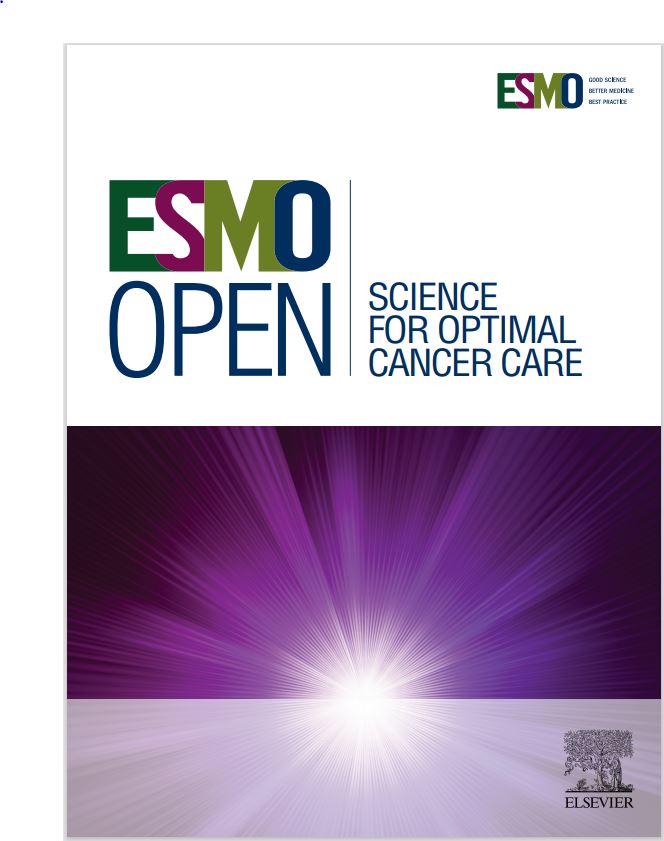早发性结直肠癌患者表现出独特的分子指纹:来自1209名患者的大规模NGS研究的见解
IF 8.3
2区 医学
Q1 ONCOLOGY
引用次数: 0
摘要
早发结直肠癌(EO-CRC,≤50岁)与平均发结直肠癌(AO-CRC)相比,表现出独特的临床和生物学特征,但其整体分子谱仍未得到很好的研究。材料和方法我们回顾性分析了1209例转移性结直肠癌患者,使用FoundationOne®CDx(一种临床验证的针对324个癌症相关基因的下一代测序方法)进行了分析。患者分为eo型crc (n = 298)和ao型crc (n = 911)。基因组改变,包括扩增、缺失和点突变,在两组之间进行比较。总生存率(OS)通过1:1的倾向评分匹配队列进行评估,调整了关键的临床和分子协变量。结果EO-CRC患者表现出独特的基因组图谱,其特征是MYC、RAD21、GNAS和MAPK1扩增的发生率较高。他们也经历了CDKN2B缺失和复发性突变,包括APC∗、NRAS Q61L、PIK3CA和TP53 G266V。这些差异具有统计学意义,表明不同的致癌途径。当比较匹配分析时,EO-CRC患者的OS明显低于AO-CRC患者:总体匹配组35个月比41个月(P = 0.0326),东部肿瘤合作组表现状态0的患者35个月比44个月(P = 0.0026), RAS/ braf突变亚组27个月比44个月(P = 0.0024)。结论EO-CRC患者表现出独特的生物侵袭性分子特征,其特征是与细胞增殖和环境应激反应相关的基因发生显著变化。这些观察结果支持EO-CRC作为一种潜在的独特临床实体的分类,并表明针对年龄相关分子谱定制的个性化治疗策略值得进一步研究。本文章由计算机程序翻译,如有差异,请以英文原文为准。
Early-onset colorectal cancer patients exhibit a distinct molecular fingerprint: insights from a large-scale NGS study of 1209 patients
Background
Early-onset colorectal cancer (EO-CRC, ≤50 years of age) exhibits unique clinical and biological characteristics when compared with average-onset CRC (AO-CRC), but its overall molecular profile is still not well studied.
Materials and methods
We retrospectively analysed 1209 patients with metastatic CRC profiled using FoundationOne® CDx, a clinically validated next-generation sequencing assay targeting 324 cancer-related genes. Patients were classified as EO-CRC (n = 298) or AO-CRC (n = 911). Genomic alterations, including amplifications, deletions, and point mutations, were compared between the groups. Overall survival (OS) was assessed through 1 : 1 propensity-score-matched cohorts adjusted for key clinical and molecular covariates.
Results
Patients with EO-CRC showed a unique genomic profile marked by a higher incidence of MYC, RAD21, GNAS, and MAPK1 amplifications. They also experienced CDKN2B loss and recurrent mutations, including APC∗, NRAS Q61L, PIK3CA, and TP53 G266V. These variations were statistically significant, indicating different oncogenic pathways. When comparing matched analyses, patients with EO-CRC had notably poorer OS than those with AO-CRC: 35 months versus 41 months in the overall matched group (P = 0.0326), 35 months compared with 44 months among Eastern Cooperative Oncology Group performance status 0 patients (P = 0.0026), and 27 months versus 44 months in the RAS/BRAF-mutated subgroup (P = 0.0024).
Conclusions
Patients with EO-CRC show a distinctive and biologically aggressive molecular profile, marked by significant changes in genes associated with cell proliferation and responses to environmental stress. These observations support the classification of EO-CRC as a potentially distinct clinical entity and suggest that personalised treatment strategies tailored to age-related molecular profiles warrant further investigation.
求助全文
通过发布文献求助,成功后即可免费获取论文全文。
去求助
来源期刊

ESMO Open
Medicine-Oncology
CiteScore
11.70
自引率
2.70%
发文量
255
审稿时长
10 weeks
期刊介绍:
ESMO Open is the online-only, open access journal of the European Society for Medical Oncology (ESMO). It is a peer-reviewed publication dedicated to sharing high-quality medical research and educational materials from various fields of oncology. The journal specifically focuses on showcasing innovative clinical and translational cancer research.
ESMO Open aims to publish a wide range of research articles covering all aspects of oncology, including experimental studies, translational research, diagnostic advancements, and therapeutic approaches. The content of the journal includes original research articles, insightful reviews, thought-provoking editorials, and correspondence. Moreover, the journal warmly welcomes the submission of phase I trials and meta-analyses. It also showcases reviews from significant ESMO conferences and meetings, as well as publishes important position statements on behalf of ESMO.
Overall, ESMO Open offers a platform for scientists, clinicians, and researchers in the field of oncology to share their valuable insights and contribute to advancing the understanding and treatment of cancer. The journal serves as a source of up-to-date information and fosters collaboration within the oncology community.
 求助内容:
求助内容: 应助结果提醒方式:
应助结果提醒方式:


